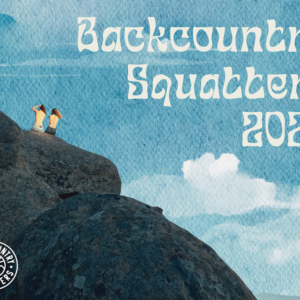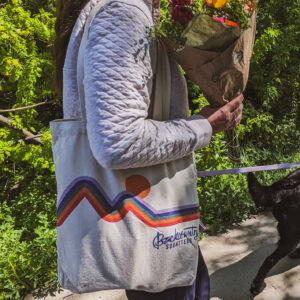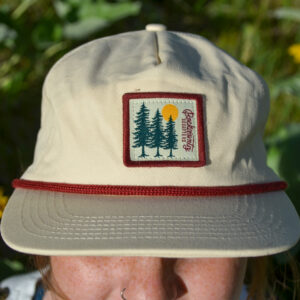Sacred Land
Only as I’ve gotten older have I begun to realize how problematic colonial narratives of the West truly are and how much they have shaped my life; I saw that I grew up on sacred land.
Where are you from? It may seem like a simple question, but it rarely has a simple answer. When I moved to Amherst, Massachusetts to attend college, I would tell people that I was from Santa Fe, New Mexico. What I didn’t tell them was that when I was a young child we lived in a pink adobe house with blue trim, a vegetable garden out back and a single aspen tree out front, surrounded by dead and dying grass and weeds. The railroad tracks ran past our neighborhood, and at night the train would shake the walls gently. Sometimes we would walk through the alley and out to those tracks where fine dust swirled in lazy circles at our feet. Tall trees stood guard over that alley; in the fall their leaves softened our steps and I imagined myself in a secret passageway.
Later, we moved to a different house near those same tracks. Out front there is a stunted peach tree, a remnant of a peach on a distant day just after we’d moved in. I was five; I held the pit in my hand, its juice oozing over my fingers. I bent down and, cupping a handful of dirt away, sunk the pit into the dry ground outside the front door. “That will never grow,” said a family friend. But it did. Hence, the tree. Sometimes, we would go for walks in the arroyo near our house, and later, runs. In the winter, my Dad works at Taos Ski Valley, and we would drive up to see him and ski on weekends. I know that drive by heart. Past the shuttered storefronts of Espanola the two-lane highway follows the Rio Grande as it snakes through Orchards and spring blooms in Velarde; wrinkled cottonwoods and junkyards; a vineyard and mobile homes and the New Wave boathouse in Rinconada, once surrounded by sunflower stalks the size of me; vintage red gas pumps in Embudo; the small river communities of Rio Arriba County. Further north, past Pilar, the river becomes a deep fissure in the land, a 600 foot deep cut that dramatically bisects the Taos Mesa beneath the mountains. There’s a skull on Taos Mountain; a bald patch etched into the mountainside. The skull looks out on it all and gapes a toothy, knowing smile.
What I couldn’t explain that year in Amherst was that there is something fundamentally different about the land out west, land which I ached for. It was more expansive. There was more room to think. In rural western Massachusetts I felt crowded by the dense forests and sprawling New England towns that punctuated well-worn hills. The landscapes of Northern New Mexico have taken root in my psyche and spiritual beliefs, and tie into the larger discourse on ‘The West,’ seated squarely within romantic ideals of the open road and the wild freedom and intrigue of the Southwest. Only as I’ve gotten older have I begun to realize how problematic colonial narratives of the West truly are and how much they have shaped my life; I saw that I grew up on sacred land. I’ve realized how outdoor recreational activities like skiing arise from a White European ideal and view of wilderness. And I’ve realized that the separation of ‘nature’ and ‘civilization’ is a construct borne of Western European ideals; rather, the landscapes I experience are complex and socially influenced.
The more I learn about the places that make me who I am, the more I see the urgency behind asking tough questions. Why did we grow up where we did? What is the history of that land and the people who lived there before us? What does it really mean to own land? When people do not connect to place, what happens to our planet? As species continue to die out, winters shorten, forests burn, reservoirs dry up, and ocean levels rise, we lose irreplaceable pieces of the natural world. But we also lose our histories; we lose our homes; we lose ourselves.
Many of us are already seeing these changes. I grew up in drought and I can’t remember the last time we had several consistent snow years back-to-back. I wonder if things continue the way they are going, whether I will be able to continue to connect with the land the way I do now. Most of all I think of the summit of Kachina Peak, a place that has given me solace for years, a place where I did my first big mountain skiing competition, and later, where I numbly scattered the ashes of my teammate. We had shared in the mountain’s sunlight and chased each other down her gullies; now, a piece of him is there forever. Kachina, a part of the human-designated Taos Ski Valley, but also a small piece of “wildness,” situated just a few miles from Taos Pueblo’s sacred Blue Lake. Bighorn sheep look on curiously at tourists in ill-fitting ski boots and now, a brand-new triple lift. Prayer flags grace the mountain’s highest point, standing guard over the living and the dead.
Even if I cannot begin to unpack what these places mean, what I do know is that Place matters. Place is who we are and where we’ve been and what we want to be. And we cannot forget these places. After all, we’ve shaped them as much as they’ve shaped us. When I returned home after a difficult year in Massachusetts, I looked out my family’s kitchen window at the pine and Juniper on Atalaya mountain, and I remembered that this place had always been with me.
Author:Eliza Donahue



